I had the Injustice Gang in mind from the start as a villain team for the Justice League of America set. They’re called the Injustice Gang, for cryin’ out loud—a direct threat to any team with the word “Justice” in its name. I like the fact that Lex and many of the Arkham villains worked together to try to take down the JLA. I even had it in my head that I wanted to make the Arkham characters work well with the Inmates team. But the idea of dual-affiliated characters was still a couple months away.
The first theme I wanted to explore for the team was token characters. Many TCGs have used token characters to represent armies of little dudes summoned forth by powerful overlords. Queen Bee was the character that got me started on this line of thinking. Soon, characters like Tattooed Man and Circe joined the group of characters who could create something out of nothing.
It was while discussing my early design direction that the development team talked me out of it. Traditionally, token characters in card games are represented by scraps of paper, pennies, or face-down game cards you aren’t using. You see the problem? Face-down cards are a big part of Vs. System. Not to mention that token characters would probably have a cost of 0, meaning no stun endurance loss for you. And would they have team affiliations? There’s just too much information on a Vs. card for a scrap of paper to represent easily.
So, what did I do? I made them actual cards—unaffiliated Army characters, of course. Yes, in my original file, Injustice Gang characters weren’t the only ones who could generate characters, so I didn’t want to put them in a team. Gypsy, Cynthia Reynolds and Henry King ◊ Brainwave, Sinister Psionic could create Illusionary Warriors, while Aquaman, King of the Seven Seas could create Fish. (Just kidding on the last one . . . )
Unfortunately, small unaffiliated Army characters can’t team attack or reinforce each other, so they’re really bad. After testing them out for a couple weeks, we saw that they needed an affiliation. Since the Injustice Gang was far and away the king of the summoners, the Army characters went into their team. This also added four more characters to the I-Gang roster, which was having a hard time topping twenty.
The other team theme I wanted to explore was “taxing.” With a name like “Injustice,” I thought they should be doing unjust things—like making you pay endurance (or other penalties) every time you played a plot twist, recruited a character, flipped a location, drew a card, and so on.
Below, you can see the evolution of the Injustice Gang characters and how these themes worked themselves out into the Army-generating, hand-flood team you have today.
Key
Original: November 2004. By the middle of that month, I had given each character in the set a “first pass” power. These were heavily thematic powers that helped me see where team themes might present themselves.
Turnover: March 8, 2005. This was the day I turned over my design file to the developers.
Development: April 19, 2005, a week after ally became what you see today. Sometimes, the development team made changes. Sometimes, they came to me asking for a rewrite.
Final: This is the text you see on the card today.
Infernal Minions
Original
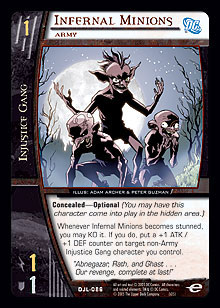 It wasn’t a character card in my first pass. Originally, Felix Faust created scraps of paper that were called Malevolent Demons. Fortunately, the development team talked me out of the token concept.
It wasn’t a character card in my first pass. Originally, Felix Faust created scraps of paper that were called Malevolent Demons. Fortunately, the development team talked me out of the token concept.
Turnover
It’s now a 2-cost, 2 ATK / 2 DEF unaffiliated Army character.
“Malevolent Demons can attack hidden characters. <p> While you have ten or more cards in your KO’d pile, Malevolent Demons gets +2 ATK.”
This little devil worked well with the Secret Society theme of getting ten or more cards into your KO’d pile. At this time, Felix Faust, Infernal Dealmaker was a member of the Secret Society. But since he is better known as a solo villain, I decided to make Felix unaffiliated.
Development
It’s now a 1-cost, 1 ATK / 1 DEF member of the Injustice Gang.
“Ally: Whenever a character you control becomes powered-up, you may remove a character card in your KO’d pile from the game. If you do, target player loses 1 endurance.”
Now almost all of the summoners were in the Injustice Gang, so we moved the 1-cost Army characters to the team. Unfortunately, this version was still too much of a Secret Society card.
Final
“Concealed—Optional <p> Whenever Infernal Minions becomes stunned, you may KO it. If you do, put a +1 ATK / +1 DEF counter on target non-Army Injustice Gang character you control.”
The card was renamed Infernal Minions late in the process and traded ally for concealed—optional. Now it works very well with Tattooed Man, Living Ink, but it still has some use in the Secret Society.
IQ
Original
 He started out a 1-cost 1 ATK / 1 DEF.
He started out a 1-cost 1 ATK / 1 DEF.
“Concealed <p> Whenever a character an opponent controls readies, its controller loses 1 endurance.”
Take that, Teen Titans Go!, Cosmic Radiation, and anyone trying to the play the game in general!
Turnover
“Concealed <p> Pay 1 endurance >>> Whenever a character an opponent controls readies this phase, that character’s controller loses 1 endurance. Use this power only once per turn.”
I thought it might help to make it work in just one phase per turn. But this was still too much of a tax, and being concealed meant you just had to suck it up all game.
Development
It’s now a 2-cost 2 ATK / 3 DEF.
“Concealed <p> You may look at the top card of any deck at any time. <p> KO IQ >>> Target player puts the top four cards of his deck into his KO’d pile.”
As you now know, we scrapped all of the various taxing powers except for card drawing, but IQ wasn’t part of that yet. Here we have some deck depletion going on outside of the Secret Society to create some team-up synergies.
Final
“Willpower 1 <p> Whenever an opponent draws a card, he loses 1 endurance.”
As a psionic, he was eligible for some willpower, and now he has one of the last remaining true taxing powers in the set.
Zazzala ◊ Queen Bee
Original
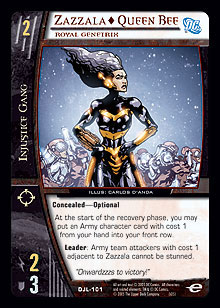 She started out as a 2-cost 1 ATK / 2 DEF.
She started out as a 2-cost 1 ATK / 2 DEF.
“Concealed <p> Characters named Bee-Trooper you control get +1 ATK / +1 DEF. <p> Activate >>> Put a 1 ATK / 1 DEF Bee-Trooper token character into your front row.”
I had her creating scraps of paper that you’d laughingly call Bee-Troopers.
Turnover
She’s now a 2-cost 1 ATK / 3 DEF.
“Concealed <p> Characters named Insectoid Troopers you control get +1 ATK. <p> Activate >>> Put a character card named Insectoid Troopers from your hand into your front row.”
With Insectoid Troopers as an unaffiliated character, having to activate to put one from your hand into play was weak.
Development
She’s now a 2-cost 2 ATK / 3 DEF.
“Concealed <p> Army characters with cost 1 you control cannot be stunned while team attacking. <p> Activate >>> Put an Army character card with cost 1 from your hand into your front row. Use this power only during the recovery phase.”
The development team didn’t want to have summoners reference specific Army characters, as that doesn’t work well in Sealed Pack play. The “no stun” power was quickly shown to be way too good if you had a lot of Army guys in play.
Final
“Concealed—Optional <p> At the start of the recovery phase, you may put an Army character card with cost 1 from your hand into your front row. <p> Leader: Army team attackers with cost 1 adjacent to Zazzala cannot be stunned.”
Now as a leader, the “no stun” power isn’t game-breaking, but it still works incredibly well with her Insectoid Troopers, Army. They were made to work with her better than anyone, though any of the summoners can use them.
David Clinton ◊ Chronos
Original
 He started out as a 3-cost 3 ATK / 3 DEF.
He started out as a 3-cost 3 ATK / 3 DEF.
“Activate >>> Target character cannot attack this turn unless its controller controls no other ready characters.”
This was a way to order combat for your opponent (sort of a tax), but it would really hose team attack decks.
Turnover
It’s now a 4-cost 7 ATK / 7 DEF.
“Whenever an opponent uses a non-activated payment power, that opponent chooses and exhausts a ready character he controls.”
This was part of the early taxing theme, but this was way too easy to play around.
Development
It’s now a 3-cost 4 ATK / 5 DEF.
“When David Clinton comes into play, you may return a character you control to its owner’s hand. If you do, return target character with cost 2 or less to its owner’s hand. <p> Whenever a character returns to an opponent’s hand from play, each player draws a card.”
This proved to be a bit too good, as you could return an Army character and probably get it back into play for free.
Final
“At the start of the recovery phase, you may return target character with cost 1 or less to its owner’s hand. <p> Whenever a character returns to an opponent’s hand from play, each player draws a card.”
Now it works well to fill your opponent’s hand or to save one of your own Army characters from the KO’d pile. Now that he will survive until the recovery phase, your opponent has a chance to do something about him.
Lex Luthor
Original
 He started out as a 3-cost 4 ATK / 4 DEF.
He started out as a 3-cost 4 ATK / 4 DEF.
“KO a non-stunned character you control >>> Draw a card. <p> Boost 2: When Lex Luthor comes into play, put a +1 ATK / +1 DEF token on each character you control.”
I originally had this Lex working well with the Army theme. But the KO to draw was a bit too good in Army decks.
Turnover
“Whenever an opponent uses a location payment power, that opponent loses X endurance, where X is the cost of that location. <p> Leader: KO an adjacent non-stunned character >>> Draw a card.”
This was part of the early taxing theme, but since a player could just stun him before using a location power, it was weak for Lex. Now the “KO to draw” power only worked with adjacent characters.
Development & Final
It’s now a 3-cost 4 ATK / 5 DEF.
“At the start of the build phase, each of your opponents draws two cards. If he does, that opponent cannot play more than one plot twist this turn. <p> Leader: Characters adjacent to Lex Luthor have the Injustice Gang affiliation.”
Actually, the development version had the draw happening during the draw phase. But that would let the Titans get around the effect by way of USS Argus. Can’t have that. Even though he is dual-affiliated, we decided not to make his leader power grant the Revenge Squad affiliation.
The Joker
Original
 He started out as a 5-cost 9 ATK / 9 DEF.
He started out as a 5-cost 9 ATK / 9 DEF.
“At the start of your attack step, target an ongoing plot twist an opponent controls. Move that plot twist to your resource row. If you do, KO a resource you control, and the owner of that plot twist puts the top card of his deck face down into his resource row.”
I had the version name “Headline Stealer” on this character from the get-go, and it survived all the way to print.
Turnover
“At the start of the combat phase, you may reveal the top two cards of target player’s deck. Remove one of the revealed cards from the game and put the other card on the top of that player’s deck.”
While the power changed, you can still see the stealing of headlines theme.
Development
He’s now a 4-cost 7 ATK / 7 DEF.
“When The Joker comes into play, each opponent cannot play plot twists from his resource row this turn. <p> Cosmic: Each opponent cannot play plot twists from his hand with cost less than the number of cards in his hand.”
Now he’s on track with the hand flood theme by denying your opponent the chance to use up all those cards in hand. This proved too good on the turn you recruited him, but you can see the final card forming.
Final
The Joker, Headline Stealer
It’s now a 4-cost 8 ATK / 7 DEF.
“Each opponent cannot play plot twists from his hand with cost less than the number of cards in his hand.”
The hand flood theme was risky and needed more consistent protection than a cosmic power was likely to grant.
Floronic Man
Original
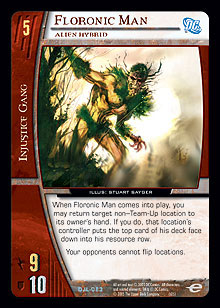 He started out as a 4-cost 6 ATK / 6 DEF.
He started out as a 4-cost 6 ATK / 6 DEF.
“Replace a location you control >>> Put an X ATK / X DEF Plant token character into your front row, where X is the cost of the location you replaced this way. Use this power only once per turn.”
The token characters I wanted to generate out of thin air weren’t all going to be 1 ATK / 1 DEF. It would have been very ugly to have various token characters hanging around where each had the same name but different stats to keep track of.
Turnover
It’s now a 5-cost 9 ATK / 9 DEF.
“Discard a location card >>> Put a character card named Plant Creature from your hand into your front row. Use this power only once per turn.”
Creeping Doom is a better name for the Army plants, huh?
Development
It’s now a 5-cost 9 ATK / 10 DEF.
“When Floronic Man comes into play, each player may search his deck for a location card, reveal it, put it into his hand, and shuffle his deck. <p> Your opponents may not flip locations.”
In development, we realized that there were too many characters on the team that generated Army characters. This removed the last character that was thematically tied to the Creeping Doom, Army. But it was decided that we wanted to keep them in the set anyway, as the team needed four options for Army strategies.
Final
“When Floronic Man comes into play, you may return target non–Team-Up location to its owner’s hand. If you do, that location’s controller puts the top card of his deck face down into his resource row. <p> Your opponents cannot flip locations.”
He still works with locations, but now he’s part of the hand flood theme and has some utility.
Scarecrow
Original
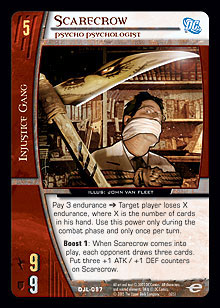 He started out as a 3-cost 3 ATK / 5 DEF.
He started out as a 3-cost 3 ATK / 5 DEF.
“Activate >>> Target player loses 1 endurance for each character he controls.”
As part of the early taxing theme, this character would’ve been better against the I-Gang than as a part of it.
Turnover
It’s now a 4-cost 8 ATK / 6 DEF.
“Activate >>> Target player loses X endurance, where X is the total willpower of characters he controls. Use this power only during your attack step.”
Way too narrow! Taxing willpower would either be completely useless or (against a GLC deck) way too good.
Development
It’s now a 5-cost 9 ATK / 9 DEF.
“Pay 3 endurance >>> Target player loses X endurance, where X is the number of cards in his hand. Use this power only during the combat phase and only once per turn.”
Now that the taxing theme focused only on your opponent’s draws and cards in hand, his power was switched to be the main burn of the team. However, he needed a way to ensure that he would do more than the cost he paid.
Final
“Pay 3 endurance >>>Target player loses X endurance, where X is the number of cards in his hand. Use this power only during the combat phase and only once per turn. <p> Boost 1: When Scarecrow comes into play, each opponent draws three cards. Put three +1 ATK / +1 DEF counters on Scarecrow.”
Now with boost, he can make sure you’re getting a good return on your 3 endurance investment.
Libra
Original
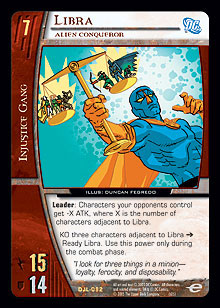 He started out as a 6-cost 12 ATK / 12 DEF.
He started out as a 6-cost 12 ATK / 12 DEF.
“Leader: KO three adjacent characters >>> Ready Libra, and he cannot attack this turn. <p> Libra gains all activated powers of characters opponents control as if Libra possessed them.”
Libra was one of the first characters to give me the idea for the “evil leader” riff you see in the set. He was also quite skilled at draining power from heroes and increasing his own power in the process. He was all about taking advantage of others.
Turnover
“Leader: KO three adjacent characters >>> Ready Libra, and he cannot attack this turn. <p> Cosmic: Libra gains all activated powers of characters opponents control as if Libra possessed them.”
I thought it might be too good, so I added cosmic, but it’s actually too weak even without it. How many late game characters have activated powers, and what are the odds that your opponent will be playing them?
Development
It’s now a 7-cost 15 ATK / 14 DEF.
“Leader: KO three adjacent characters >>> Ready Libra, and he cannot cause breakthrough this turn. <p> While another character has flight, Libra has flight. <p> While another character has range, Libra has range.”
While his copy power was similar to Mimic, Calvin Rankin, we thought it would be fun to give him the flight and range copying ability, but take away the full copy power. Hmm . . .
Final
“Leader: Characters your opponents control get -X ATK, where X is the number of characters adjacent to Libra. <p> KO three characters adjacent to Libra >>> Ready Libra. Use this power only during the combat phase.”
We finally managed to combine his evil leader tendencies with his Power Siphon ability to weaken opponents. Now he can attack twice in a turn, should you be in a particularly evil mood.
I like the tension created by the evil leaders. Sure, sometimes it’s a no-brainer when you use an evil leader’s power, but I like that you may sometimes be willing to give up a perfectly healthy teammate to enable a larger character. I especially like the fact that there is a slight downside to using Libra’s evil leader power. When he goes in for the second attack, the defender won’t have a -3 ATK penalty like the first defender did.
I think this was the most interesting team in the set to work on because it underwent the most changes between my original file and the final product. I really like the fact that its taxing theme and Army theme both make equal use out of many of the same support cards and characters while working toward two separate strategies. Army decks need to draw a lot of cards to keep pumping out Army characters, while the hand flood theme wants everyone to draw a lot of cards. Focusing the taxing theme on just one aspect of the game made the team much more coherent and not just a pain in the butt to play against. Don’t get me wrong—it’s still a pain to play against, but now at least you know how they’ll wreck you.
Next week, I’ll trace the evolution of the Secret Society. Send questions or comments to mhyra@metagame.com